The Sunk Cost Effect

There are many many many many many books that teach you how to make money, but almost none that show you how to avoid losing your money. I personally had never really thought about this, at least not until I read the book What I Learned Losing A Million Dollars (an amazing book that I strongly recommend). Like everyone else, I was more concerned about making money rather than about how not to lose it. But as Jim explains it, there are many ways to successful make money but few to lose it all. You can invest in opposite strategies and still make money! The key to long term wealth is to understand the psychological forces that induce us to lose our money, even through our best efforts.
The book What I Learned Losing A Million Dollars starts off with Jim’s personal story of how he quickly climbed up the success ladder and then in a matter of a few months lost his entire wealth. What’s most interesting about the book is that what happened to him could happen to anyone. But the scariest part is how fast it can happen. It’s not that he did stupid things or spent wildly, it’s that he got caught up in a psychological trap. One that we all fall prey to from time to time, just on smaller scales.
Once it was all over for Jim, he went on a quest to find what the best investors did. What he found is that there was no consistency, they were all over the place. Many of them contradicted themselves and still succeeded. This lead him to question how this was possible, after all in most cases when two people use the opposite strategy one person has to come out ahead at the expense of the other. That’s how the markets work.
What he found out was that this wasn’t necessarily true. What happens is that successful investors know when to stop, when to drop an investment. Investors using opposite strategies aren’t always in the market, they’re in the markets at different times. They know when to wait on the sidelines until the markets favor their strategy. They don’t fall prey to as many psychological traps as ordinary people do. That is the only common thread he was able to find for highly successful investors!
And today we’re going to discuss one of those very common traps. It’s the effect of looking at your previous costs in determining whether or not to go forward today, otherwise known as the Sunk Cost Effect.
To give you a common example unrelated to investing, just to show how prevalent and strong this effect is, let’s take the example of car ownership. Let’s assume you own a car that’s a few years old (still pretty new) and you’ve just spent $2000 in repairs on it a couple of months ago. Suddenly this week it starts misbehaving, you bring it to the garage, and find out you need to spend another $1000, $2000, or even say $4000 on it. What do you do?
The best answer is to look at the value of the car TODAY and determine if it’s worth it TODAY. However, and this is where we almost all fall prey to the sunk cost effect, is that we also look at the fact that we just spent $2000 a couple of months ago. We’ve already spent that much money on it, so we might as well go forward with the new repairs. We don’t want to lose that $2000 in repairs from a couple of months ago. We may even rationalize that what we fixed a couple of months ago won’t break down again for some time so the car is better for it. And that’s a big problem!
What happens now if in another month we get another bill for another $2000? Well you have to get the repairs, after all you just spent $3000-$5000 in the last few months. And then what happens in another couple of months if it repeats. Oh my god!! We just spent $5000-$9000, there’s no way we want to lose all that money and/or effort. And so the vicious cycle has started and we start to lose more and more money just because we didn’t want to lose that initial $2000!! Trying to avoid losing that initial $2000 repair bill has now cost us around $10,000, and it’s only going to get worse! If the car is a lemon, how long will it take for us to give up? If you think it was hard at $2000, imagine now at $10,000! The more you lose, the harder it gets to pull out!
And it’s not just with cars, it can happen with just about anything. It can happen with your job. You may have already committed 3, 5, 10, 20 years to this job. You may hate it, it may be paid below market rates, and so on. But since you’ve already committed so much to it, you’re probably less and less likely to quit with time. This is why people get caught up in jobs they don’t like for years and years.
With investing, in real estate it could be you’ve already spent so much money renovating a property that you now have to wait to sell it until the market recoups, losing money each month for years and years, possibly losing everything through bankruptcy to avoid losing that $10,000 you initial spent on renovations. In the stock market, it’s a stock you bought at too high a price that you’ll now hold onto until it goes back to at least it’s original price. The list goes on and on.
The reality is that we should always look at whether something is worth it as of today. Period. It doesn’t matter how much time or money we spent on it in the past, we need to look at how much it’s worth today. If you can do that, you will save yourself a lot of trouble and money!
And that’s what smart investors do. They evaluate an investment in terms of what it’s worth today, they don’t look at how much they’ve already invested. In other words, you should always ask yourself: If I wasn’t already committed would I invest into this today? If the answer is no, then you need to seriously consider getting out of your investment before you fall prey to this trap, otherwise it will be that much harder as your position gets worse!
Permalink to this article Discussions (1)
13 Bad Excuses For Not Starting Your Business
If Nick Vujicic from the video above can do it, to be quite honest, then you better have a really good excuse why you can’t. If you’re not interested and it’s not for you, then that’s different. But if you’re using any of the excuses listed below, then I’m sorry but we’ve all heard them before. We know them all too well. These are 13 excuses, NOT REASONS, most people use for why they can’t start a business. The reality is you can, you just don’t want to enough. Because if you did, you’d find a way. None of them are reasons, they’re all excuses. And today I’m going to dispel each and every one of them.
1. I have no time.
Seriously? I call BS on that one. Almost everyone, and I mean almost everyone, has some free time or time that’s wasted.
Do you watch any tv shows? Do you go to any movies? Do you watch any sporting events? Do you go the pub/bar? Do you go out for dinners? Do you hang out on the patio or have barbecues with your friends on the weekends? I understand everyone needs time off to relax and so on, but no one said it was going to be easy either. If you do the math, and really look at how you spend your days, I have no doubt you can find at least 10 hours a week. And everyone can find at least a few hours each week!
2. I don’t know how.
Here’s a big secret, no one else really does either. There is no manual to being an entrepreneur. We just figure it out as we go along. The more experience you have, the better you get at it. Just like anything else.
If you want to look at it another way, it’s like riding a bike. No one knows how to ride a bike on their first try. But if you don’t start trying you won’t learn. The same is true with swimming, dancing, learning a new sport, learning a new language, programming. Even using a cell phone. It wasn’t that long ago that most people would say they couldn’t use a cellphone, and now almost everyone has one.
And unlike in the past, there’s a lot more information out there today. You’re not limited to just your local library, you can order virtually any book from Amazon. And if you don’t have the money, you can always research everything you need online on the internet. There’s no end of entrepreneurial information out there. The fact alone that you’re reading this article means you’re already learning from the internet!
3. I don’t have the money.
And? Only a really small subset of companies actually require a significant amount of money to get going. There are many many many businesses that require very little money initially to get started. Sure IT based companies like software companies probably do require less cash (and instead require a lot more time) that a lot of other businesses, but don’t think that’s it. There’s lots of different businesses out there.
In all honesty, the problem is because most people think too big for their first company. If you really want to succeed, start on a smaller scale. Just like when you start driving a car. Is it smart to learn how to drive a car in a Ferrari or is it better to learn in a basic sedan? Do you learn to fly a plane by flying a 777 Jumbo Jet your first time in the air or do you start with a basic 2 seater plane? Therefore start a smaller business, something you can build up from, and go from there. Use the money you earn from your first business to build your second.
PS: Do you have an LCD tv? Have you taken a trip in the last while? What kind of car do you own? Do you go out to restaurants? Do you go to the movies? If you really want to, I’m sure you can find some money.
4. I don’t know where to start.
There is no perfect place to start. But like the saying goes, a journey of a thousand miles starts with one small footstep. You need to start and the rest will just happen. The biggest hurdle is generally just taking that first step. And don’t stop once you’ve started, keep going. That’s another major hurdle most people fall prey to. They get excited, take a few steps, and then basically just stop taking any steps. Don’t let that happen to you.
5. I’m too young/old.
Really? What’s too young or too old? If you’re reading this, then you’re neither too young or too old. Age is a perception thing, it’s really all in your mind. It’s not a valid reason.
6. No one will give me any money.
Fine, then start something else. This is back to #3, maybe you should start something smaller. Don’t try to fly a Jumbo 777 jet your first time flying. Just because no one will give you money for THAT SPECIFIC business, it doesn’t mean you have to stop everything. There’s more than one business in the world.
At the very least, you can look at starting a smaller idea. It’s the same as when you start your career. No one will hire you as the president or CEO of their company when you first start. You have to build up your career, establish yourself. Start with a smaller business and create a history of success.
7. I’m waiting for the perfect idea.
Good luck with that. You’ll be waiting forever. There is no such thing as the perfect idea. And to be honest, there’s lots of ideas out there. Executing on your idea, I would say, is more important than the idea itself.
8. What if I fail?
What if you fail? What’s the worse that can happen? As Tim Ferris put it in his book The 4-Hour Work Week, what’s the absolute worse that can happen if you fail? If you really think about it, it’s probably not nearly as bad as you think. For sure you won’t die.
And failure is not a bad thing. Of course you’d prefer to avoid it, but so what if it happens. Imagine if you had the same avoidance of failure with everything you did. How would you ever have learned to drive? And by the way you can die learning to drive! How would you have learned to ride a bike? How would you ever visit a foreign country? Learn a new language? Learn to fly a plane? Learn to dance?
9. I don’t have the skills or experience
Were you a professional driver when you first got your driver’s license? Where you a professional basketball player the first time you tried to play basketball. What about doctors? They have to start somewhere. Everyone has to start somewhere, including entrepreneurs.
Don’t worry too much about this. Early on you’ll make more rookie mistakes, but that’s part of learning. As time goes on, you’ll find it gets easier and easier. For example, how difficult was it when you first started driving? Did you make silly mistakes (while still surviving)? Did it take almost all of your concentration? Did you drive at full speed? Now how do you drive? Is it much easier? Now you’re probably not thinking about the details, you’re thinking more of your route (strategy) rather than how much to push on the accelerator and if you’re too close to the car in front of you (daily busy work). Those things become intuitive after a while.
10. There’s too much competition.
There’s no such thing as too much competition. A large number of competitors means the market is too segregated which means there’s no dominating player. That’s really good!
If there’s only a few big competitors, you’re in even better luck! The big guys are just as scared of you as you are of them. Once a company has become big, bureaucracy sets in and doing anything, especially anything innovative, becomes very hard. Which also means don’t try to compete with them head on where resources are the key to success, focus on where they can’t compete! Innovation, customer service, quickness of execution, and so on.
By the way, competition is a good thing. It’s much harder to be the first because not only do you have to sell your product or service, you also have to educate people about it. Personally I prefer only having to deal with one hurdle at a time.
11. I have to wait until everything is lined up just right
This will never happen. All entrepreneurs will tell you this is a pipe dream. You’ll never have everything perfectly lined up.
Now that doesn’t mean don’t plan and try to prepare beforehand, it just means don’t ever expect to have everything perfectly lined up to start because it won’t happen. And in all honesty, no business ever goes 100% smoothly. You just have to roll with punches and adjust as you go.
My favorite analogy, which I’ve taken from the software world, is the classic example of driving a car. When you drive, do you lock your steering wheel and move forward, or do you continually make small adjustments, turn when needed, and so on. If you locked your steering wheel, you probably wouldn’t even make it past your street. The same is true with business. Nothing ever lines up perfectly, you just have adjust as you go.
12. It’s just too risky.
Is it really? How risky is your job? With a business you have multiple clients whereas with your job you have just ONE SINGLE CLIENT. All your eggs are in one single basket. So if your one single client decides they no longer need you, or they can no longer afford you, you’re revenues (paycheck) goes to $0. With a business, if one client drops you because they themselves run out of money, it’s not the end of the world because you generally have many other clients.
By the way, if you run your own company, you know what’s going on. As an employee, you can easily be blindsided and laid off at any moment. And we’re seeing a lot of that today. You’re at the mercy of management, which means you may not know until the last minute. Not only that, but it’s possible you could lose your job just to improve a balance sheet for investors and nothing more. You really have no control of what may happen, nor are you always going to have knowledge of what’s coming.
13. I’m still working on my business plan
This is my favorite which I saved for last! I’ve seen too many would-be entrepreneurs working on their business plans forever, never to actually execute on it. It’s much much much easier to write a business plan than to start a business. Plus you don’t have to push through all the hard walls and issues you’re going to encounter when starting.
Common variations of this are people who move from business plan to business plan. People who endlessly try to perfect their business plan. People who work on the minute details of their business plan forever.
By the way, a business plan is really just to give you an idea whether your business concept is feasible or not. Don’t ever try to execute it to the letter, it will never work as written. What you’re doing is writing down your assumptions and projections, that’s it. As you develop your business, you’ll find where you made errors in your assumptions and projections, and you should adjust accordingly. Trying to force a business plan to life is a recipe for failure. It’s really more of an initial guideline, almost to force you to think about what you’re going to do before you do it.
You’ll also find that as you become more and more entrepreneurial, you’re less and less likely to write up a business plan. After you’ve run a few companies, you don’t need to go through all the detailed planning because you already have a good idea of what’s coming ahead. Plus, your business plan rarely survives it’s first encounter with real customers. But if you’ve never started a business, it’s a good place to start. Just don’t focus too much on getting it perfect, or ironing out all the details. The business plan’s goal is to help you develop your idea, not write it in stone. You don’t have to follow your business plan perfectly, no successful entrepreneur ever does!
Permalink to this article Discussions (3)
You Can Only Achieve What YOU Believe You Can Achieve

What’s the furthest you believe you will go in life? Do you believe you will own your own company? Do you believe you will be the boss at your job? Do you believe you will climb Everest? Do you believe you will make $1,000,000? Do you believe you will marry the most amazing person?
Firstly, notice I said believe and not think you can. With that in mind, which of the above questions do you truly believe you will achieve?
Now here’s the kicker, I can pretty much guarantee you that if you don’t believe you will achieve it, then you won’t. It’s not very complicated, it’s really that simple!
In the movie Fired Up!, an Animal House style movie, there’s a scene where the team believes they suck and because of that they do! That’s when the hero chimes in with a pretty colorful and somewhat offbeat speech about the importance of believing that you’re good. Below is the exert with some edits (to keep it cleaner for this blog):
– Sorry, guys, I just suck.
– It’s not just you. We all kind of suck.
– We’re not good at all.
– Hey, stop. Stop talking like that.
– But it’s true.
– We’re just not that good.
– Stop.
– Enough of that. You can go as far as you want.
– What do the Panthers have that you don’t have?
– Skills.
– Athleticism.
– Kickass cheers.
– Laser hair removal.
– Big-a** t******. I’m just saying.
– Confidence. They’re cocky a*******.
– Like Nick, the cockiest a******* on the football field. That’s why he’s good.
– He’s right. I’m awesome.
– Because he believes in himself.
– Also because I’m awesome.
– He knows he’s gonna be good, so he’s good. And he takes chances.
– Not hard due to the fact that I’m awesome.
– Nick. Trying to make a speech here.
– I’m sorry.
– Either bet big or go home.
– If you don’t wanna take any chances, then you shouldn’t even be here.
– I know you wanna be here, because you finish last every single year… but you keep coming back… even if it means taking endless shit… from total dong-knockers like the Panthers.
– All right. Come on, guys. Let’s be cocky a*******s.
– Yeah, you know what, he’s right.
– And I can say that… because I am the best cheerleader here, so you can all suck my d***.
– I was just being a cocky a*******.
– Oh, nice. That’s what I told you. Look, did you see what she was doing there?
– That’s exactly what I want from everybody.
– All right, let’s do this.
– And remember, you’re awesome. Let’s risk it to get the biscuit.
– All right, get cocky, b******.
– Let’s do it. Come on, guys. Ready.
– Hit it!
Although a bit colorful, and not exactly what I meant the idea is still really there. If you don’t believe you will succeed you won’t. And because the team thought they were bad, they always finished last.
As an aside, if you don’t believe in yourself, you’ll never take chances, which means you can never really lead. Part of success is also knowing how to create your own luck.
Let’s look at a more concrete example that you can associate in your life. Let’s say you’re making $50,000/year right now and you believe you can’t make more than $65,000. Will you ever make $75,000? No! Why? Because if you don’t think you can make that much, you’ll never ask for that much. You’ll never try to make that much. You won’t do what it takes to make that much. You may achieve up to $65,000, but you’ll never go above that level because that’s as much as you believe you can make.
The same is true with your dream job, the raise you want, the promotion you want, and so on. If you don’t believe in it, you will never try or get it. The very fact of not trying alone will prevent you from succeeding.
And it’s not just jobs, the same is also true for finding your perfect girlfriend/boyfriend/wife/husband. How many people are just too shy to approach the person they really like? They just sit there and wait, thinking they don’t deserve that person. They never take the chance. How many movies are about someone in love but never having the courage to take that initial leap?
The reality is that you have to believe you will succeed to succeed. When I started LandlordMax, I knew it was going to be a success. It was a fact a fact in my mind. And it is succeeding!
As Jeremy Clarkson from Top Gear so well put it in the Bolivia Special episode (4:48): “If you believe something will happen, it will happen”.
Whichever questions above you answered no to, I can almost guarantee you won’t ever achieve. If you don’t believe you can do it, you won’t. It’s not very complicated, it’s really that simple!
In the movie Fired Up!, an Animal House style movie, there’s a scene where the team believes they suck and as such they do! But then our hero explains, in a pretty colorful and more entertaining method, the importance of believing that you’re good. The following is the exert:
Looking at a more concrete example. Let’s say you’re making $50,000/year right now and you believe you can’t make more than $65,000. Will you ever make $75,000? No! Why? Because if you don’t think you can make that much, you’ll never ask for that much. You’ll never try to make that much. You won’t do what it takes to make that much. You may achieve up to $65,000, but you’ll never reach above that level.
The same is true with your dream job. If you don’t think you deserve or can do it, you will never try for it. The very fact of not trying alone will prevent you from succeeding.
And it’s not just jobs, the same is also true for finding your perfect spouse. How many people are to shy to approach the person they really like? They just sit there and wait, thinking they don’t deserve that person. They never take the chance. How many movies are there about someone trying to fall in love with their dream person but never having the courage to take that initial leap?
The reality is that you have to believe you will succeed to succeed. When I started LandlordMax, I knew it was going to be a success. As a matter of fact, I also didn’t really have a choice. It had to succeed. As Jeremy Clarkson from Top Gear put it in the … episode, if you believe it enough, you can will it to happen!
Jeremy clarkson
Sorry, guys, I just suck.
– It’s not just you. We all kind of suck. – We’re not good at all.
– Hey, stop. Stop talking like that. – But it’s true.
We’re just not that good.
Stop.
Enough of that. You can go as far as you want.
What do the Panthers have that you don’t have?
– Skills. – Athleticism.
– Kickass cheers. – Laser hair removal.
Big-ass titties. I’m just saying.
Confidence. They’re cocky assholes.
Like Nick, the cockiest asshole on the football field. That’s why he’s good.
– He’s right. I’m awesome. – Because he believes in himself.
Also because I’m awesome.
He knows he’s gonna be good, so he’s good. And he takes chances.
Not hard due to the fact that I’m awesome.
– Nick. Trying to make a speech here. – I’m sorry.
Either bet big or go home.
If you don’t wanna take any chances, then you shouldn’t even be here.
I know you wanna be here, because you finish last every single year…
but you keep coming back…
even if it means taking endless shit…
from total dong-knockers like the Panthers.
I wanna cut the blond one.
– What? – What?
– What? – What?
– What? – I’m just saying.
All right. Come on, guys. Let’s be cocky assholes.
Yeah, you know what, he’s right.
And I can say that…
because I am the best cheerleader here, so you can all suck my dick.
I was just being a cocky asshole.
Oh, nice. That’s what I told you. Look, did you see what she was doing there?
That’s exactly what I want from everybody.
All right, let’s do this.
And remember, you’re awesome. Let’s risk it to get the biscuit.
All right, get cocky, bitches.
Let’s do it. Come on, guys. Ready.
Hit it!
Permalink to this article Discussions (1)
Top Entrepreneur Movies to Watch
In no particular order:
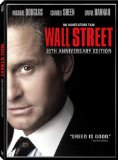 |
Wall Street (1987)
There are numerous lessons to be learned from this movie. It’s probably THE most famous business. What’s more, it’s still amazing today, 20 plus years later! Some of my favorite quotes include: “It’s not a question of enough, pal. It’s a zero sum game, somebody wins, somebody loses. Money itself isn’t lost or made, it’s simply transferred from one perception to another”. “Life all comes down to a few moments. This is one of them”. The most valuable commodity I know of is information”. And probably the most quoted: “Greed is good.” Although the above quotes are mainly about greed, which is the central theme of this movie, there are many many many lessons to learn. There’s ambition, taking chances, the power of information, and so on. An interesting tidbit, one of the pivotal scenes of this movie is quoted as part of another movie in this list (The Boiler Room). |
 |
Startup.com (2001) The story of a group of friends from high school who decide to start a dot com business at the height of the dot com boom (aka mania). It starts off as you would expect, with lots of excitement and energy. But as the business grows, VC money becomes more and more important since there is no real revenues. To avoid spoiling the movie for those that haven’t seen it, let’s just say a lot of issues have to be dealt with. This is a great movie for people thinking of starting a business with a group of friends, of exactly what can happen and what you should discuss beforehand. Plus it show the importance why a business should be run to be profitable. The whole movie is really about getting the next round of VC (Venture Capital), it’s not about how to grow the business to earn more money. I don’t even remember this being discussed once in the whole movie! |
 |
The Secret of My Succe$sThe Secret of My Succe$s (1987)
The Story of an ambitious young man who wants to conquer corporate America. Although he doesn’t climb through the proper channels and there’s plenty of 80’s style “you can do anything”, there’s lots of good lessons. For example, in the movie he was able to climb just by filing the proper paperwork! Some great lessons include the power of charisma, the power of information, the value of social networks, and so on. Although this may be a more arguable point, that sometimes it takes a bit more than hard work to get ahead, you also need to create your own luck. I would of course not recommend creating luck the way Brantley (played by Michael J. Fox) did in the movie, but the idea is that he took his destiny into his own hands. |
 |
Jerry Maguire (1996)
Ignoring the two big quotes from this movie: “You had me at hello” and “Show me the money”, this movie is what entrepreneurship is all about. Jerry is a successful agent for his clients at a large firm when he comes to the realization that things aren’t working for him. He writes a mission statement of what the company should be, where agents should have less clients so that they can foster better relationships. Needless to say, this doesn’t go well. So he sets off on his own to start his own company with his own clients which will be run according to his mission statement. He will focus his business on managing less clients but taking more time and effort with each client. On building relationships with them. And like any business, the start can be rough. It never quite goes as planned (it honestly rarely does – double to triple your estimates, and not your best estimates), and in this movie he almost loses everything. But he is able to pull through, and he does succeed. |
 |
Hitch (2005)
You might be wondering why this movie is in the list, it’s because it’s not just about romance. Business is about understanding your customer’s problems and finding solutions to those problems. In this case Hitch is a successful consultant not only because he’s good at what he does, but also because he’s figured out what his customers want, even when they don’t really know it. What’s also interesting is this is one of the few movies you see someone be selective with their customers, and even fire their customers. Hitch interviews all his clients to make sure their intentions are good, and only then will he work with them. If he finds out later that they aren’t, he immediately fires them. All around a good movie showcasing the importance of understanding what your customers problems are and finding solutions for them. As an added bonus, he always demonstrates the power of word of mouth marketing! His business is not exactly something you want to advertise on a billboard, so it has to be through word of mouth. And he is successful. |
 |
Forrest Gump (1994)
Shrimp anyone? Even Lieutenant Dan didn’t believe Forrest could start a shrimping business. The main lesson here is that it doesn’t take brilliance to start a business, anyone can. Sure Forrest had a little luck because of a storm that wiped out his competition, but had he not tried he never would have gotten anywhere. And he definitely wouldn’t have been on the cover of Fortune Magazine as depicted in the movie. Starting and running a business takes more than skill. It takes a lot of hardwork. But most important, you have to actually start the company! As I’ve said before, Ideas are a Dime a Dozen. Not to downplay them, but the concept is that coming up with an idea is not hardest part of a business, executing the idea is. And in the movie, we see Forrest does just that! |
 |
Baby Boom (1987)
A high powered executive (known as the Tiger Lady) inherits a baby and suddenly finds her life turned upside down. She eventually makes the decision to move away to the country to raise the baby. Once there, she comes across the idea of creating high quality baby foods for a niche market. Being the 80’s and all, there’s the classic montage of her building her business into a very successful business, so successful that her previous company offers to buy her out. The biggest lessons learned from this movie are about the importance of niche markets. How it’s important to focus on thing and be the best at that thing. Had she created another brand of baby food, it would’ve just been another baby food company, and she would’ve had no chance. Instead she found a segment of the market she wanted, then she spend some time analyzing that market for it’s potential (yes, you actually see her analyze her market segment/niche in the movie). It’s important to have a USP (Unique Selling Proposition), and J.C. (the high powered executive) definitely figures hers out. |
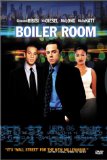 |
Boiler Room (2000)
You would think this is the movie to show you what not to learn about business because it’s all about scamming your customers. True, I agree, but there are still several things to learn. My favorite quote: “And there is no such thing as a no sale call. A sale is made on every call you make. Either you sell the client some stock or he sells you a reason he can’t. Either way a sale is made, the only question is who is gonna close? You or him? Now be relentless, that’s it, I’m done.” That’s right, this movie is mainly about high pressure sales tactics. Although I personally disagree with this kind of sales tactic, but it’s still important to understand because it will eventually be used on you. They also discuss about market segmentation, but not exactly in those terms. They discuss how some customers are more profitable then others, and how to identify them. How to determine which are the fat whales. There are some other great lessons in this book, especially the importance of questioning a too good to be true deal. You’ll definitely get learn something from this movie. |
| Pirates of Silicon Valley (1999)
Who doesn’t know Bill Gates or Steve Jobs? What better movie can there be on business than the story of how those two started their companies. Although it’s not exactly known for it’s accuracy, it’s still an amazing movie with a lot to learn from. These are two different people that both succeeded wildly yet took very different paths to success. What’s also very interesting is the impact of some of the decisions they made early on. There’s a saying that basically goes along the lines of, you can be good in business and succeed, but you need to be both good and be lucky to succeed wildly. They were both good, and fortunately for both for them, they also both made some very good decisions early on. |
|
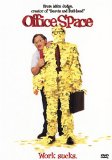 |
Office Space (1999)
How can this movie not be on the list. It’s a classic! Of course it’s not so much about learning how to run a business as it is about how NOT to run a business! But still this movie is just too hilarious to leave out. Examples of how not to run your business include TPS reports. Or having a dozen managers ask you about your TPS report. Can you imagine having to deal with that many managers? One of my favorite quotes is: “Yeah, I just stare at my desk; but it looks like I’m working. I do that for probably another hour after lunch, too. I’d say in a given week I probably only do about fifteen minutes of real, actual, work.”. How can you expect any company to excel and lead if you’re people are that de-motivated. |
 |
Cocktail (1988)
In this movie Brian (played by Tom Cruise) is a very ambitious young man excited to get his start in the business world. He quickly learns that none of the big companies are interested in hiring him without a degree, so he unrolls at the local city college and starts a part time job where he meets his counterpart for the movie. Together they go through quite an adventure. They decide they’re going to open their own bar called Cocktails and Dreams. But to do this, they need money, and this is where they start to diverge on their paths. This also where the biggest lessons can be learned. Having a business partner is not something to do on a whim. It’s very difficult, you need to have the same goals, you need to be able to work together through the tougher times, you basically need to work better together than an old married couple. Above that, and the usual business lessons, another interesting aspect of this movie is that not all money to start your company is equal. That is to say, just because you can get money, it doesn’t mean you should. It may or may not be worth the costs. So be careful when you take money for your business, make sure it’s worth the cost for you, not just personally, but also that you’re not giving away too much for it. |
 |
Rudy (1993)
Rudy is here because it’s so inspirational. Rudy is a movie based on the true story of a “5 foot nothin’, 100 and nothin’ with barely a speck of athletic ability’ man who achieved his dream of playing in a football game for Notre Dame. No one believed he could, not even his family or friends, no one. However through sheer will and determination Rudy was admitted to Notre Dame, got on the football team, and got to play one game. That’s amazing considering he had everything going against him! He worked hard, he persevered where most people would’ve quit. He worked so hard that when the coach said he wasn’t going to be able to play him on his last possible game, the football team revolted and refused to play unless he got dressed. Not only that, they got him on the field. And best of all, as far as I understand Rudy was the only person ever to be carried off the field on the shoulder’s of the other players. That’s how much they respected his dogged perseverance! |
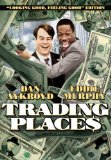 |
Trading Places (1983)
In this movie two investors/businessmen decide to make a $1 bet to see if they can turn a successful person into a homeless criminal and homeless criminal into a succesful business person. It has all the charm of an 80’s comedy. But above that, the two main characters invest and work the commodities market, along the way exposing mis-perceptions about the American Dream. And as a benefit, you’ll actually get to learn about how the commodities market work. And if you’re a bit confused by how the end goes, the following is a good explanation. |
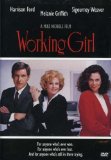 |
Working Girl (1988)
Ignoring the massive 80’s Big Hair, this movie is the story of Tess’s climb up the corporate ladder during the big Merger & Acquisition fad of the 80’s. Above the normal business lessons, this movie really shows the importance of social skills in business. Not only do you need to be smart, but you need to be able to work with people. You need to understand other people’s needs. You need to be able to communicate with other people. And most importantly, it really helps if other people believe in you. |
 |
Aviator (2004)
This is the story of Howard Hughes, from his beginnings all the way to the end. Even though Howard had some personal issues, but he was still an amazing businessman. How many people are willing to make the types of bets he did on succeeding? Betting the whole company many times over? There’s no doubt he was a very smart person, but he also had a lot of ambition and was willing to put his money where his mouth was. And not just on a small scale, but on a massive scale. What I found most interesting is that all the while he was creating and growing his company he was also battling some very big inner demons. He was able to succeed where most people would’ve crumbled, and he built a largely successful company above that. |
 |
Newsies (1992)
Business is not all about making smart decisions and executing on them, it’s also very much about the people behind the business. Without people there is no business. And this movie is in this list because it shows the importance of people. Not so much about getting the right people, that’s another lesson, but in treating your people right. In the movie, the owner of the newspaper company basically decides to decrease the pay of the newsies, which they don’t appreciate. This leads to a strike. Do remember of course that this movie takes place many years ago, when child labour was common and striking wasn’t unionized as it today. In any case, the lesson here is to remember to treat your employees well. This not only includes paying them what they deserve, but also treating them the way you’d like to be treated. It will make a difference in the long term, as Hearst (the owner of the newspaper company) learned the hard way. |
 |
Click (2006)
As important as your business is to you as an entrepreneur, you also have to realize that there are other things that may be even more important. In this movie, Michael (played by Adam Sandler) learns the hard way that climbing the corporate ladder isn’t the most important thing in his life. His family is the most important thing. When starting, and even when running a largely successful company, too many entrepreneurs focus solely on their companies forgetting almost everything else, even their own basic health! And in some cases, they sometimes wear this as a badge of honor. Yes your business is important, but is it the most important thing in the world? You should always ask yourself what the most important thing in the world would be if you had a heart attack today? |
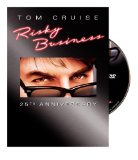 |
Risky Business (1983)
First there’s the obvious standard business lessons. You need a product that people want. You need to market it. You need to … But what’s more interesting is the underlying theme of this movie, which is how greed can corrupt people. Joel starts off innocently enough, but by the end of the movie his business venture isn’t exactly what you’d call mainstream. Mainstream or not though, all businesses obey the same core principles. As he describes at the end, his business is “Dream Fulfillment”. Find what a customer needs and fill that need. |
 |
Tucker: The Mad and his Dream (1988)
To quote the tagline: “When they tried to buy him, he refused. When they tried to bully him, he resisted. When they tried to break him, he became an American legend. The true story of Preston Tucker.” If his story doesn’t inspire you to build your company, I don’t know what will. What’s great about this movie is that it shows that sometimes you need more than sheer will, you also need a bit of salesmanship to go along with it. You need to to sell people on your idea, and more importantly on you! |
 |
Gung Ho (1986)
Although dated, this film shows that business isn’t just about ideas and execution, it’s also a lot about culture. And although this movie is about the 80’s business Japanese business culture clashing with the 80’s American business culture, it’s about a lot more than that. Mergers and acquisitions aren’t always as rosy as they appear on paper. Just because two businesses can appear to have “synergy”, it doesn’t mean they will work well together. But the biggest lesson to take away is that all business have cultures that get established within them. These cultures can be good or they can be bad for the business. It’s therefore very important to cultivate cultures that will benefit the company, especially because it’s extremely hard to change them later. |
 |
Tommy Boy (1995)
“Holy Schnike”, Tommy Boy is on this list? Yes it is. Why? To quote Ray Zalinsky (played by Dan Aykroyd): “Truth is, I make car parts for the American working man because I’m a hell of a salesman and he doesn’t know any better.” In other words, a great product doesn’t make a great business. It sure helps, but it doesn’t guarantee you’ll succeed. Betamax was better than VHS. The Mac was better than Windows in the 90’s. There’s countless examples of products that were superior but lost out. To succeed at business you need to be able to sell and market yourself. |
 |
You’ve Got Mail (1998)
Although the central theme of this movie is the love story between Joe Fox and Kathleen Kelly (played by Tom Hanks and Meg Ryan), it’s also about a small company having a big competitor move into it’s market. It’s generally better if you can be the aggressor, but if not, you need to be prepared and learn how to differentiate yourself. In this movie Kathleen’s store is very different from Fox Books, it’s personable, it’s memberable, and so on. But it’s still not enough to compete with discount prices on commodity items (the same book can be purchased cheaper down the street). She wasn’t able to learn how to differentiate herself enough before it was too late. Therefore the lesson here is don’t try to compete head on with a big company on their terms, find another way to compete with them on your terms, one which you can hands down beat them. And go from there. |
 |
Family Man (2000)
With anything else, you need to have balance. And to reach the very top of success requires a lot of sacrificing, which Jack (played by Nicholas Cage) has done in this movie. But is it worth it? Is all the money worth it? Maybe, maybe not. Assuming you don’t want to be the very best of the best, it’s important to realize that starting a business does require some sacrifices. If you want to start a business at night and on the weekends, then that’s coming out of your free time. Also expect it to take a long time, there’s no way you can do it in just a few short months. If you want to go even bigger than that and quit your job, then expect to be working more and harder than your full time job to get your company started. Success does require a great deal of effort, it isn’t easy. Otherwise everyone would be doing it. |
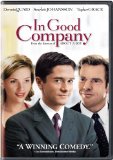 |
In Good Company (2004)
The most obvious business lessons to take from this movie is that there are multiple ways to successfully run a company. And there are the multiple approaches to building up your client base. In the movie Dan does it through social networking while Carter does it through cross-promoting, etc. Both are very successful in their own ways. Another lesson I personally cherished is that just because there’s a new way to do things, it doesn’t mean it’s always the best or right way. In many cases it is, but not always. How many of you remember the main business strategy of the dot com era? The idea of getting as many eye balls on your company’s website as possible, no matter what the cost. Dominate the market segment and then figure out how to be profitable. Always, always, listen and understand why it was done the way it was done before you jump into a new way of doing things. |
Honorable Mentions
The following are more great business related movies that you can benefit from watching, movies that I could have made fit in this list but would have made the list too long to read. They include:
- Click (2006)
- Clerks (1994)
- Mr Mom (1983)
- For Love or Money (1993)
- Greedy (1994)
- Fun With Dick and Jane (2005)
More Mentions
The following are related movies that are suppose to be really good but that I just haven’t yet seen:
- The Triumphs of the Nerds (1996)
- Glengarry Glen Ross (1992)
- E-Dreams (2001)
- Barbarians at the Gate (1993)
- Rogue Trader (1999)
- Code Rush (2000)
- Big Night (1996)
- The Corporation (2003)
- Capitalism: A Love Story (2009)
If I missed any please add them below in the comments.
Permalink to this article Discussions (2)
How to Get a Pay Cut AND Be Happy About It

Let me start by asking which you’d prefer:
- A 10% raise?
- A 3% raise?
If you’re like almost everyone, the answer is hands down #1. But let me re-phrase the question a bit. Which would you prefer?
- A 10% raise in 1980?
- A 3% raise in 2009?
Is your answer still the same? I bet you think it’s a trick question because I added a year to the options. You’re right, it IS a trick question! The years 1980 and 2009 are special. Can you guess why? 1980 is very well known for having a very high inflation rate whereas 2009 is known for being a deflationary year (a year where the inflation rate is negative). In 1980 the inflation rate was 13.5% whereas in 2009 it was -0.4%. Having brought this new information to light, is your answer still the same?
In other words, which do you prefer:
- 10% raise at 13.5% inflation in 1980 = a real -3.5% raise in terms of purchasing power
- 3% raise at -0.4% inflation in 2009 = a real 3.4% raise!
Looking at the numbers adjusted for inflation, option #2 is now by far the best economical choice, beating option #1 by almost 7%!! Option #1 is actually a pay cut!
Now here’s the kicker, although most people realize option #2 is the best economically, the majority of us FEEL that the person in option #1 is HAPPIER with their raise than the person in option #2. Notice here I said feel happier, NOT that they were financially ahead! Although we’re able to differentiate between the two, most people still believe they would feel happier with option #1!!
What’s more, this same research paper (Money Illusion) also discovered that people believe the person in option #2 was more likely to leave their job. Basically, as William Poundstone summarized in his book Priceless, the overall theme of the paper is:
“$$$ = happiness = actual dollars NOT ADJUSTED FOR INFLATION”.
So how do you get a pay cut and be happy about it? Get a raise, but have that raise be less than the rate of inflation.
Permalink to this article Discussions (0)
2009 – A Year in Retrospect

2009 has been my busiest year to date since I’ve started blogging almost 4 and a half years ago and founded LandlordMax 6 years ago! Looking back, it’s hard to believe everything that’s happened. Which is why I’m going to take a breather today and look back at 2009, to share with you all that’s happened. Every once in a while I like to do that, and it’s been way too long since the last time.
When 2009 started, LandlordMax (the property management software company I founded) was growing at a very nice pace and the real estate market hadn’t collapsed as far as it has today. We were in the process of trying to release our biggest ugprade, version 6.05. We were also trying to get a Mac version out in the first half of the year, and hopefully get much further on the networked multi-user version. I had also just published my book Blog Blazers (November 2008) in which I had interviewed 40 top bloggers about their take on blogging. Above that I was in the process of a major redesign of this blog. Those were the major items on my plate as 2009 started.
Overall it mostly went as planned, with some surprises and exceptions. The biggest unexpected was just how much work it was going to take to make it all happen. If I had known ahead of time just how busy 2009 was going to be, I probably would’ve been a lot more stressed. Sometimes ignorance is best. In any case, here is my journey broken down into sections:
LandlordMax
Just to quickly re-iterate, LandlordMax is the company I founded about 6 years ago. The company primarily builds and sells property management software to real estate investors, property management companies, property managers, banks, colleges, and anyone else who needs to manage rental properties. The software manages the accounting, workorders, invoices, leases, tenants, buildings, and about a million other things. It’s a very useful and powerful piece of software.
When 2009 started, we were very actively working on a major upgrade of LandlordMax, which eventually was released as version 6.05 in May 2009. In it we included many new features, including a large amount of charting, email integration, Outlook support, whole new sections (accounts, contacts beyond tenants, vendors, etc.), over 20 new reports to the already more than 100 reports, and lots of other exciting new features. It was a massive undertaking that although started long before the year began, was finished before the year ended.
The only downside is that we couldn’t offer all the features we had wanted to and release it within a reasonable time. For example, we wanted to offer a feature we called “Archiving”, but as we tried to implement it, I realized it was going to be a major undertaking, taking more time than I wanted to get this version completed.
We also tried to get check printing into the software but had I to make the very hard decision to push it to a future release. After having committed a lot of time and money to check printing, it became clear that it wasn’t going to be doable within the time frame we had. So for now, this is a feature that has been put on hold. I hate to see all that effort put on hold, especially after having already invested so much effort and time, but it was the right decision. It was the hardest decision I that I had to make in 2009.
That being said, LandlordMax version 6.05 was very successfully released in May 2009. The feedback and comments we received have been amazing. Here’s just a few samples of the latest testimonials: 1, 2, 3. And those are just the ones I’ve published here on my blog, there’s many more on the LandlordMax Success Stories page.
Within days of version 6.05 being released, a big push went forward to make it available on the Mac. We’ve been working on this on and off for some time, going as far back as 2007. The problem with the Mac version is that there’s always tons of small and extremely annoying differences that need to be correctly handled. Things from how the installer works to how the program is rendered on the Mac. But this year I decided we had to make it happen no matter what. What I initially thought was going to be a certain amount of worked turned out to be a lot more than I had planned. And I mean a lot more! On the scale of 3-5 times more work!
Back in August 2009, I was already mentioning here how the Mac version was going to be coming very soon. That we only had one issue remaining. How wrong I was! A month later, in September I wrote about it again saying how wrong I was in my last post. We had resolved it, but now there were other issues.
One issue that was particularly troubling was due to the fact that LandlordMax is built on the Java platform. On the Mac, Leopard uses Java 5, and Snow Leopard uses Java 6. There is no overlap, and you can’t choose one version or the other, they each use a different version. Which means to support Leopard and Snow Leopard we needed to make LandlordMax fully Java 6 AND Java 5 compliant!! We’d been planning to upgrade to Java 6, but we were hoping to push that off until after the Mac version was released. Turns out we had to deal with it now.
At the end of October, we finally released the Mac version of LandlordMax! And it was compatible for all versions of the Mac OS, Leopard and Snow Leopard. Not only that, but you could take a backed up database file from the Windows version and move it to the Mac, and vice versa. In other words, you could use LandlordMax interchangeably on the Mac and Windows!
The Mac version of LandlordMax has since been received with lots of enthusiasm as shown in this initial testimonial, with many more to come. But in terms of estimated cost, we spent several times more than I had initially planned. And this is after having already committed lot of resources in the past.
During all this, the property management software market has dramatically changed. A company that’s been buying up many of our competitors over the last couple of years in the hopes of becoming a major player, Domin-8, has filed for chapter 11 bankruptcy. They acquired companies such as Rent Right, Spectra, Tenant Pro, iCam, Management Plus, and so on. This is big news because most companies have very limited success after filing for Chapter 11. Not only this, but we’re already starting to see people jumping ship as they’re learning the news. No one wants to be stuck with a software from a company that’s no longer around, especially with the speed of technology today. Which means 2010 may be a very interesting year for the property management software market. A shakeout year…
And as you all know by now, the real estate market has also been going through a major recession! You would expect our sales to be impacted negatively, but quite the contrary has been going on! Our revenue growth hasn’t stopped in the slightest, we’re still growing at the same fast rate as before as shown below (the graphs below only include sales of LandlordMax):
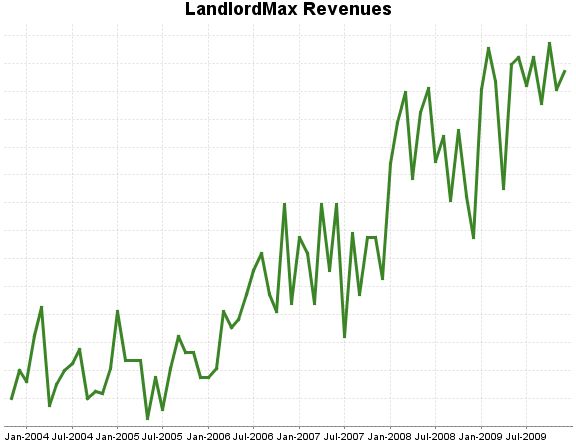
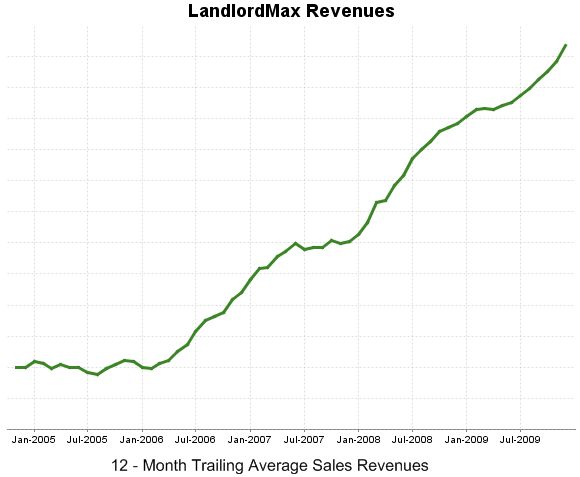
All in all, it’s been a great year for LandlordMax. Things have definitely been going in our favor. The only thing we haven’t yet succeeded in doing is releasing the networked version. A lot of work has already been done here, but the progress has been slower than I’d have liked. Not because it’s hard or a lot of work, which it is, but because I’m always having to allocate effort away from it to other more immediate items. For example, to get LandlordMax version 6.05 out on time, we had to pause the effort on the network version for several months. And for the Mac version, well let’s just say that all the effort was focused on the Mac version during those months. Like I said before, the Mac version required much more work than anticipated and I made the commitment to follow it through, even at the cost of delaying other items.
Which means that this year, we’re now working very hard on the network version. I expect there will be a new version of LandlordMax before the networked version is available, but I can’t confirm this. I also believe it won’t be until at least late in the year that the networked version will be available, if not in 2011. Above this, the website is in the process of going through a major uplift! That’s what’s going on right now. We’ll see what happens. I can’t wait to write a similar post when 2011 comes on what happened this year!
Blog Blazers
In November of 2008, I published the book Blog Blazers. In Blog Blazers, (also available on Amazon), I interviewed 40 top bloggers, (bios can be found here). The book took me a good year to publish and I’m very proud of the results. In it I asked everyone the same questions so that you the reader can compare apples to apples and oranges to oranges. Not only that, but one of my goals was to make sure the questions had a lot of follow-up material so that you could continue learning after you were done reading the book. Questions such as What was your most successful blog post ever? Which books and websites do you recommend to new bloggers? What’s your best tip for writing a successful blog post? To name just a few. I even wrote some follow up posts to help people find further resources such as 10 Most Popular Books in Blog Blazers.
Because the book was released in mid-November, it was just in time for the Xmas rush. And of course, because it’s a new book from a new company (Levac Publishing House – owned and operated by yours truly), there were some initial distribution issues. For example, Amazon will only initially order a limited number of books for new books and from new publishers. And because of this, Blog Blazers was almost immediately out of stock on Amazon. The good thing is that although it took alittle bit of time, we were able to resolve the issue quickly enough. And of course, it’s a good problem to have!
Other than that small initial glitch, Blog Blazers as a whole has been a pretty smooth ride. Most of the issues with the book were in it’s production, the marketing and sales was fairly similar to LandlordMax. Actually, I learned so much from the production side that I ended up writing a 3 part series on how to publish a book. Here is the link to the series: Part 1, Part 2, Part 3.
The biggest thing I learned about publishing books is that profits can only really be made by selling books in large volumes. You have to move at least 10,000-100,000 books to make any kind of money. Less than that and I’m at a loss how you can make any profit (assuming you have a marketing budget). The profit margins are definitely lower than I expected. To be honest, I really did learn a lot more than I ever expected about the book publishing industry. I now have a very big appreciation for the effort that goes into making a good book, and just how hard it is to produce and succeed. I now thing that books in general are under-priced. That being said, lots of copies of Blog Blazers were moved. Right now there’s just a fraction of what I initially printed left before I need to make a decision on the next print run. So that’s pretty exciting.
In regards to how the book has been received, it’s gotten a ton of glowing reviews. It’s been reviewed on major websites, blogs, magazines. It’s landed me several interviews, podcasts, radio spots, video reviews, guest appearances, etc. It’s been used used for a workshop at Drake University. What’s also very excited is that on Amazon, a site known for it’s reviews, Blog Blazers has gotten an average 4.5 star out of 5 stars! Almost no books get 5 star reviews, it’s extremely rare. Most books get anywhere from 3 to 4 stars. 4.5 stars is exceptional!
As the year has been wrapping up, I’ve had to decrease my marketing efforts. Right now the book is mainly selling itself through word of mouth. I might put another big marketing push or two, but I don’t expect to put as big a marketing push as I did in 2009. It’s a lot of work and because of that I believe it took a lot of my time away from LandlordMax. It was ok for 2009, but I can’t commit as much time to promoting Blog Blazers in 2010 as I did in 2009, not with everything coming down the pipe for LandlordMax.
Overall though, Blog Blazers was a success which I’m very proud of it. The only thing is that in retrospect had I known beforehand what it takes to publish a book I doubt I would have done it. The last time I had calculated, I put 1000-2000 hours into publishing the book. That’s just my time! This doesn’t include the money I invested. It’s definitely a costly endeavour. So if you’re planning to write a book, you should really check out my book publishing series I wrote on my blog (mentioned earlier). It’s a BIG project! Not that there’s anything wrong with it, it’s just nice to know what you’re signing up for before you actually do sign up.
FollowSteph
As always, in 2009 I continued to write articles/posts here. The biggest workload came from a complete custom re-design of the site. And I have to give credit to Reuben Whitehouse for it’s success. He designed the new logo, as well as the whole look and feel. If you’re interested, Reuben wrote a blog post about how he designed and came up with the FollowSteph.com logo. It’s a pretty cool post with lots of pictures and explanations on how he did it.
The other big news for FollowSteph is that the Feedburner subscriber count, which I don’t publicly post yet, has been climbing fast. In 2009, the blog grew in subscriptions by 500%!! I can’t even begin to describe how exciting that is!! Normally I’d see a 50% to 100% yearly growth, never 500% times. 2009 was a big year. Very exciting stuff!
For 2010, my main goal is to increase my blog postings, bring it back to my pre-2009 levels. 2009 was just so insane that I have to admit I didn’t post as much as I use to. Especially the last few months of 2009. In November and December I only had 2 posts each. My goal is to get back to my usual posting schedule of at least once a week, preferably more if time permits. It’s definitely not a lack of ideas and things to say, it’s a lack of time.
RealEstatePigeon.com
RealEstatePigeon.com is a completely new website/project sponsored by LandlordMax! I’ve never once talked about it. This is the very first time right now!
RealEstatePigeon.com is expected to be publicly released later this week or early next week. You’re more than welcome to check it out now, just be aware that we’re putting on the final touches as we speak. There are a few outstanding graphical issues. That and I’m in the process of seeding it a bit more before fully going public with it.
What is RealEstatePigeon.com? It’s a Q&A (Questions and Answers) website about real estate. The website is based on the success of StackOverFlow.com, a Q&A website for programmers. The idea is that you’ll be able to ask real estate related questions and get answers. Not only that, but because it’s a community website, you can also show off your real estate knowledge and answer questions posed by others.
The differentiator here is that unlike discussion forums where the answers are all listed in chronological order which makes you have to read everything just to get any idea of what’s going on, you’ll be able to quickly see the best answers. This will work because all the answers get voted on, and the best answers will get pushed up to the top based on the number of votes. So the better an answer is, the higher it goes and the quicker you can get to it.
Not only that, but the website is going to have a reputation based system. What this means is that you receive reputation points for each of your questions and answers that are up voted. The more reputation points you get, the more real reputation and credibility you get. And the more real reputation you have, the more real opportunities you’ll get offline, in the real world.
For example, on StackOverFlow people have gotten such high reputation scores that it’s attracted the attention of people looking to hire experts. Yes, opportunities are being presented to people directly because of their reputation scores! People are getting contracts because of their reputation scores. People are getting hired for work because of their reputation scores. Basically, people with high reputation scores are attracting the attention of others who want to work with them.
Therefore the goal of RealEstatePigeon.com is that not only will you get answers to your real estate questions, but you’ll will be able help others (and as a side effect show off your knowledge). And in return for helping others, you’ll be able to potentially achieve success yourself! Who wouldn’t want to work with a mortgage broker who had a high reputation score. What about a knowledgeable real estate agent? When you approach an investor for money, wouldn’t it be great to be able to show them how much you know and your reputation score? Even better, I can’t wait to hear from the first person who tells me they got approached by investors instead of them having to approach investors because of their reputation on RealEstatePigeon.com!! That’s the ideal goal! To get people come to you rather than you going to them!

2010
To summarize, in 2010 I plan to:
- Continue to grow LandlordMax
- Release at least one new major version of LandlordMax
- Get very close to releasing a networked and multi-user version of LandlordMax
- Finish the major uplift of the LandlordMax website
- Sell out all the remainder copies of Blog Blazers’ first print run
- More than double the number of subscribers to this blog
- Bring back to the posting frequency to pre late 2009
- Launch RealEstatePigeon.com with success
- And have a lot fun doing all of the above!!
Let’s see what happens.
Permalink to this article Discussions (4)
It's Only the Flu…

“Those who cannot learn from history are doomed to repeat it.”
– George Santayana
Why is there such a big push for the H1N1 vaccine right now? Why did the United-States declare a state of Emergency for the H1N1 virus? Why has the WHO (World Health Organization) been so public about escalating the H1N1 virus to a “pandemic”?
It’s because we’re learning from our past. Well hopefully we’re learning. Back in 1918 people were too slow to react to the biggest Pandemic in recorded history. And when they did react, it was either too late or too slow. The time to react is not once we’re in the midst of a full virulent pandemic storm. Rather the time to react is before it becomes virulent. Even with today’s modern medicine we still can’t cure the Influenza (Tamiflu isn’t really a cure). All we can do is prevent it and treat the symptoms.
Back in 1918, before it really struck at full force, people just kept saying it was “only just the flu”. Nothing to worry about. It’s just another cold. Yes, initially it was, but that quickly changed. And even then, many people still kept saying it was only just a flu. It wasn’t until people started dying, and even then it wasn’t for some time, that the population really started to react.
If you don’t know the history of the 1918 Influenza Pandemic, I strongly recommend the book The Great Influenza – The Story of the Deadliest Pandemic in History by John M. Barry. It’s an amazing read! The information and knowledge in the book is priceless! Not only does he follow you through the history of the pandemic, Barry also explains how influenza works and why we still need to be just as vigilant today.
The 1918 pandemic is chillingly similar to today’s pandemic. Firstly, the 1918 Influenza was an H1N1 Influenza virus, unlike the Avian Flu’s H5N1 makeup. If you’re not familiar, Influenza can come in a number of forms, H1N1 being one, H5N1 being another, and so on. Each form is different enough that if you have immunity to one it doesn’t give you immunity to another (so for example being immune to H1N1 doesn’t give you immunity to H5N1). This is why there are seasonal vaccines, there are just too many possible forms. As well, to make things more complicated, the Influenza virus can be different enough within one form to only offer partial immunity to that form (and in some cases none at all). It’s almost like variations within forms!
But getting back to the 1918 pandemic, it too started with an initial mild first wave. It’s the second wave that brought death and carnage to the world. The second wave was of the same form but much more virulent. So virulent in fact that in the most severe cases it killed within hours of when people showed the first signs of symptoms much like the death this week of the 13 year boy in Toronto who died of H1N1 with 48 hours of showing symptoms. Statistically, the 1918 flu killed anywhere from 2-20% of those infected as opposed to the normal rate of 0.1%! The good news is that in most cases it just made you really sick, but please don’t confuse that with how many people it killed. It killed complete families. It devastated whole communities. Governments in the US collapsed. Cities collapsed (Philadelphia, etc.). Booming cities became ghost towns. In terms of scale, it’s estimated to have killed over 100 million people. In today’s numbers that would be over half a billion people!
This is also incidentally why the WHO, and governments around the world, are pushing so hard for everyone to get vaccinated as soon as possible. We want to stop it dead it in it’s tracks, to prevent it from mutating into a much more virulent form. We don’t want to give it that chance. Not only that, we know that the H1N1 has the potential for being a real killer!
The similarities don’t just stop there, the H1N1 from 1918 was much more virulent to the healthy young people than to the young and elderly. Sadly, hundreds of thousands of children were left without parents after the virus had finished it’s run. Not something you normally see from the seasonal flu.
The reason it can be so deadly in young healthy people is because they are so healthy. It’s not actually the virus that kills them in many cases, it’s their own body. Rather than just sending in special soldiers and snipers from your immune system to attack the virus, it has to send in it’s full arsenal. Now in many cases, it’s not a big issue, but if the virus fights is strong, your body reacts accordingly (not exactly but close enough). So what happens is that you get your own personal World War 3 waged in your body. In most cases your body will win, but have you ever seen a battlefield after a big war? There’s not much of it left. In this case, the battlefield IS your body, specifically your lungs, so there’s not much left. This is called a Cytokine Storm.
This is often what causes you to die. And you’re lucky enough to survive the onslaught of the battle, your lungs are so beat up that they get secondary infections such as pneumonia, bronchitis, etc. In 1918 they didn’t know what to call this. Today we call it ARDS (Acute Respitory Distress Syndrome). If you get ARDS, your chances of survival are low. In 1918 you had a 10% chance of surviving. Today I believe it’s now up to a 50% chance of surviving. Better but not great. Incidentally, this is why SARS was so scary.
Just how fast can it happen? Here’s a story from the book The Great Influenza: “In Cape Town, South Africa, Charles Lewis boarded a streetcar for a three-mile trip home when the conductor collapsed, dead. In the next three miles six people aboard the streetcar died including the driver. Lewis stepped off the streetcar and walked home”.
Yes today we have better treatment for secondary infections such as antibiotics, but we definitely don’t have enough supply for a major pandemic. It’s believed that the world supply of antibiotics would be depleted early on in a significant pandemic, and manufacturers wouldn’t be able to keep up with demand. That’s part of the cost/benefit of our society’s “Just in Time” inventory. It helps reduce costs and wastage, but we don’t have much backlog. Again, we still have no cure for Influenza itself, all we have is medicine (antibiotics) to treat secondary infections.
Which is why we need to get the people who will be most sick (or most likely to pass it to others) vaccinated first. Not just because they’re more likely to suffer and die, but also because we want to be careful not to overwhelm our already over stretched medical system. In most places in North America, the medical system is already running at more than 100% capacity. That’s right, more than 100% capacity!
If you compare the medical system today to the 1918 medical system, they may have been better prepared. The hospitals back then were running well below 100%. In 1918 the bed per capita (ie number of beds for a given number of people) was much much better than it today. Even with this extra supply of bed and staff, you hear many stories from survivors who while in the hospital never saw a doctor. In some places people couldn’t get beds, even with bribes. People would lie on the floors waiting for others to die so that they could take their beds. It wasn’t pretty. And that’s with a bigger padding than today. It’s not about the quality of care, or what treatments are available, but just about being able to see a doctor!
It’s believed that our current medical system can’t even handle the extra surge from a mild pandemic! Never mind a virulent one. We just don’t have the resources for the surge in capacity. It looks like our hypothesis is about to be tested, and it’s already proving to be accurate. We are ONLY in a MILD Pandemic right now. Hopefully that’s all it will be.

The good news is that we have much better communications today. The fact that Barack Obama has already declared a state of emergency for the United States is phenomenal!! In 1918 it was hushed for as long as possible. Declaring a state of emergency early means we’re already starting to allocate resources before it’s a massive problem. It means we’re trying to prevent it rather than react. Not only that, but making people aware is a good thing. There may be some fear and panic right now, but compared to what happened in 1918, it’s way better.
In 1918 because they tried to hide the spread of the virus (it was during World War 1 and they were trying hard to boost morale – an Influenza pandemic killing millions doesn’t exactly boost morale), they created even more fear and panic. People had no idea what was going on. People didn’t trust anyone. Would you? It was a mess. Actually the cities that fared best, such as San Francisco, did so because they publicly shared truthful information. People were informed. Information was the key. And because they knew what was happening, what to expect, they dealt with it much better. The unknown is scarier than anything else. When you watch a scary movie, the anticipation up to the moment is the scariest. Once you see the bad guy, you’re no longer scared. The unknown is what’s scarier. So I only have praise for Barack Obama because he’s already started to allocate resources ahead of time. Great job!!
In terms of prevention, learning from 1918 (and other pandemics), it’s almost impossible to stop Influenza. This is why in the spring the WHO basically suggested there’s no point in stopping air travel. It was too late. With the Avian flu they still had a chance, but with H1N1 it was too late. It had already spread.
To give you an idea how far and wide it can spread, almost no one was safe in the world in 1918, before they had commercial travel like we have today. Even remote locations up in the North Pole got hit. Researchers were recently able to resurrect live samples of the 1918 Influenza from Alaska. The only communities that were able to save themselves from the 1918 Pandemic enforced very strict quarantines, almost to the point of being extreme. No ONE, and I mean NO ONE was allowed in once the quarantines were setup. Even something as innocent as a delivery of mail could devastate a community. Most communities failed, even with strict quarantines.
Yet still some were able to enforce quarantines where no one died. Communities such the town of Gunnison, Colorado. In October of 1918, in advance of the pandemic, they shut down the town for about 2 months. No public gatherings. Lawmen blocked all the roads. Train passengers weren’t allowed to get off the train to stretch their legs, not even outside. There’s even a record of a couple trying to drive through the town who got thrown in prison and quarantined. Basically they took very drastic measures but it worked. The neighboring town, Sargeant, esperienced 6 deaths of out 130 in one day. The quarantine worked. If you’re interested, you can find a list of newspaper clippings from 1918 with dates as the events unfolded here – it’s very informative.
Of course in our global world, it’s already too late. There’s no way to quarantine yourself. What you can do however is stay away if you’re sick. Please, STAY HOME IF YOU’RE SICK! This is how the virus passes. In our modern society, we’ve grown up to tough it out, throw some dirt on our wounds, and go to work. That’s the exact behaviors that cause the virus to spread. We need to change our way of thinking. If you’re sick, don’t go to work. Stay home. Don’t go out to public places. If you don’t need to go to the doctors then don’t. And especially, if you don’t need to go to the hospital then please don’t.
Even if you’ve been vaccinated, remember it’s not 100% effective. It’s 85% effective. You still have a chance of getting H1N1. However if you do get it, odds are that it will be much milder. As well, be aware that the vaccine is NOT immediate. It takes time for the vaccine to take effect. Your body has to build an immunity to it. It takes days, even weeks (I’ve read as much as 3 weeks with H1N1). In that interim, you CAN STILL CATCH the H1N1 flu. Each day you’re less likely, but you still can.
And please, please, please, if you already have the flu, don’t go get vaccinated while you have it. Firstly, it’s too late. Secondly, it won’t help, you’ve already gotten it. It’s not a cure but a prevention method! And this is why a lot of people think the vaccine is sometimes ineffective. If you were already infected but hadn’t yet shown signs (even more so if you show symptoms), it won’t do anything for you. It’s totally useless in that case. Again, it takes some time for vaccine to take effect, so you should get it sooner than later. The longer into the pandemic you wait, the less effect it will have.
For example, today in the news I read “Desrochers said she is anxious to be vaccinated because her grandson is sick with flu symptoms.” Are you serious? If you already have the flu, the vaccine is not going to help. It’s not going to make your grandson better. If anything, all you’re going to end up doing is infecting other people. It means you’re going to nullify the vaccine for everyone you come into contact with. It’s just wrong. But people are misinformed, and unfortunately the message being communicated is completely inconsistent.

I’ll give you another example. I was talking to someone locally who had just seen her doctor, and they informed her not to get the vaccine. The reason given was that it was a live virus and could be potentially dangerous because you needed a strong immune system to fight it. She is one of those high at risk. Her doctor couldn’t be more wrong. The vaccine available to her includes the dead virus, not the live virus. Secondly, she is exactly the high risk person that needs to get the vaccine. Why did it happen? Because the information traveling around is inconsistent. In marketing terms, there is no consistent message. That is to say, unless you educate yourself and your smart about what sources you refer to, etc., there’s all kinds of conflicting information. No one is stepping up and what’s happening is it’s creating misinformation, and hence fear and paranoia. We’re, sadly, repeating history in this case.
While I’m ranting, the other thing I don’t understand is why we aren’t delivering the vaccine faster. As far as I can tell here locally, it’s not the lack of vaccines that’s stopping us. What’s happening is that the vaccination clinics are only open for a few hours at a time before they decide to close down for the day so that they can close at their expected times. Don’t they understand, this is a race. It’s a race between getting the majority of the population immunized before the virus has the time to take hold, and in the worse case mutate to a virulent form. We’re not running out of vaccines right now. My local station giving the vaccine is only open between 2:30pm and 8pm. Within an hour the lineups are so bad that they have to close to let all the personnel go home by 8pm. At this rate, they’re vaccinating 4200 people in my city per day. Within a month, that’s approximately 100,000 people. In a city of about a million, that’s 10% of the population in a month, way less than majority needed. At that rate it would take until midway through next year just to hit 50%. Now I do understand that they are scaling up each day, but with doses available now, there’s no reason to close the vaccination clinics so early. If it’s a staffing issue, I’m sure there’s a solution to be found.
Since I’m on the topic of vaccinations, right now we spend more researching the West Nile virus than we do on Influenza, yet Influenza kills more people per year than the West Nile virus has killed since it was discovered. Why is that? With one pandemic, Influenza can kill more people than AIDS in several decades (the 1918 pandemic killed more people from Influenza in 6 months than AIDS has in 25 years). And not to downplay AIDS, but Influenza is much more transmittable than AIDS.
Not only that, but if you look at the economic costs of Influenza each year, just in terms of sick days, it’s very significant. It’s not a cheap virus. Why aren’t we developing a vaccine against all type A Influenzas, which would encompass all the different forms including H1N1. Because there’s not enough political interest, and hence not enough funding. If we could just invest 1%, or even 0.1% of what’s spent in Iraq (an accounting rounding error), I’m sure we’d make amazing strides forward. And the ROI (Return on Investment) would be significant. Imagine if we could wipe it out!
Alright, one last comment on vaccinations for now, if the vaccination effort is a success and the virus doesn’t have a chance to mutate to a virulent form, that is very few people die or get sick, what do you think will happen? People will start to complain that it was for nothing. That it was over-hyped. That it was a waste of time and money. That we scared ourselves for nothing. But did we? That’s success!!! Success IS that nothing happened.
If you think back to Y2K, did anything happen? No, because we invested millions, if not billions to prevent it. Unfortunately if nothing happens, people assume it was for nothing. Nothing happened on Jan 1, 2000. But you know what, a LOT of systems would have failed had we not put in such a big effort beforehand! Thankfully because of that big effort nothing happened. It was a success! Yet today people think it was over-hyped and not a big deal.
What about the Avian flu? Was that over-hyped? What happened? Nothing! Again, millions and millions of birds were slaughtered to prevent it from spreading. Every outbreak was quickly addressed. Thankfully the virus wasn’t too contagious and they were able to prevent a pandemic. A lot happened to prevent a pandemic. There’s a reason nothing happened. It was a success!
The same is true with 9/11. Before and after 9/11 many terrorists attempts were prevented. Of course we never think of that. All we think of is the one failure. Until something breaks down, it really wasn’t needed. It’s over-hyped. It didn’t do anything. That’s prevention. We need to be aware of why prevention is so important. An ounce of prevention is worth a pound of cure.
What are you waiting for, go get yourself vaccinated as soon as possible. Be a part of the solution, not the problem. Now’s the time to do something!
In the next little bit I plan to write about the vaccine, such as is it safe, what about this or that. If you want to make sure you won’t miss, you may want to subscribe here to get it by email as soon as it’s available.
Permalink to this article Discussions (5)
Why is Feedback Important?

Several months ago I had the bad luck of catch Strep Throat. Since I’ve had it several times in my life, I pretty much knew I had without having to see a doctor. But if you want antibiotics to treat it, you need to go see a doctor.
Before I continue, let me just say that the main reasons you want to treat Strep Throat with antibiotics is two-fold. Firstly in rare cases it can easily prevent some pretty severe complications. And secondly, you’re much less contagious.
In any case, I initially tried to see my family doctor but unfortunately he was unavailable for whatever reason, maybe he was on vacation or something, I just can’t remember. (by the way my current family doctor is the best doctor I’ve ever had – not only is he good, but he also cares!). Because I couldn’t see him, I went to a local walk-in medical clinic.
The doctor saw me, did a quick swab test, and of course the results came back positive for Strep Throat. However, for whatever reason, the walk-in doctor didn’t want to prescribe me any antibiotics. She was very adamant, saying that my body could, and should, fight it off naturally.
Now I understand there is a lot of abuse going on with antibiotics, but Strep Throat is an infection that can potentially lead to serious complications in some cases if not treated, and it was 100% certain I had it. Sure it might go away naturally, but let me tell you, once you meet someone who’s experienced the serious complications from this infection, you understand why they recommend treating it. So why not take the antibiotics, an ounce of prevention is worth a pound of cure. Plus, I’d be a lot less contagious.
But she refused. She said to go home, relax, and come back in a few days if got worse. So I left. But after a few hours, I had second thoughts and called the clinic. I explained that I had been diagnosed with Strep Throat, that the tests were 100% positive, and that it was highly recommended by the medical establishment to treat it with antibiotics. Not just to help fight the infection, but to help prevent any potential complications from the infection. Talking to doctor via the receptionist, she basically informed me the doctor really didn’t want to treat me with antibiotics and to come back in a few days if it got worse. I pushed some more and since it was near closing time, the receptionist said they would have to call me tomorrow.
The next day I decided to get a second opinion since I hadn’t heard anything by lunch time. I went to another walk-in clinic and saw another doctor. He quickly did another swab test and it was also positive for Strep Throat. He immediately gave me a prescription for antibiotics. I mentioned about the other doctor who refused to give me antibiotics, and asked why she wouldn’t just to get a better understanding. He said he had no idea, that with Strep Throat you should always give antibiotics. Again, this isn’t a sore throat, it’s a confirmed (now twice confirmed) case of Strep Throat.
Two or three days later, I forget now, I got a call from the initial medical clinic. This time the receptionist said that the original doctor that saw me wasn’t in today, but another doctor from the clinic would like to talk to me on the phone. She said, and I’m trying to remember the exact words as best as I can here: “You have Strep Throat and we HAVE to treat it with antibiotics. You can come in within the next hour to pick up a prescription, I’ll leave it at the front.”
Now you may ask, what was the point of this whole story? And how is it related to feedback? Well, if you look at the first doctor, she basically refused to treat Strep Throat with antibiotics. Since she’s not my family doctor, once I leave the clinic, she has no way of knowing whether her treatment was effective. Or worse yet, whether her treatment (or lack of treatment) helped or made things worse. She can only assume that things got better.
Let’s take this one step further. Let’s say her lack of treating me with antibiotics caused a rare kidney complication from the Strep Throat. How would she ever know unless I returned to tell her about it? She can’t know, and therefore she can’t learn from her mistakes. As far as she can tell her treatment was very effective since I didn’t come back.
How rare are the complications? I don’t know. But did you know it’s speculated that Mozart, the famous composer, may have died due to a kidney failure complication because of Strep Throat. Although rare, it does happens. But what’s worse is it’s so easy to prevent.
Getting back to our story, let’s say there are complications in 10% of the cases. How can any doctor from a walk-in medical clinic know (and learn) on the effectiveness of their treatments? As far as the first doctor who treated me can tell, there were no complications. No one came back. Although they might have ended up in a hospital, she wouldn’t know. She might not even be aware that another doctor from her very own clinic treated me with antibiotics. She could theoretically believe her treatment was right and continue treating her other patients the same way, re-enforcing her belief that her treatment (or lack of) works. A vicious cycle. And it’s really not her fault, there’s no way for her to know if it isn’t working.
Which is why it’s so important to have a family doctor. Unlike a walk-in clinic doctor who you’ll only see once, or maybe a few times over the years, your family doctor is going to be following-up with you on an on-going basis. Your family doctor is going to be getting feedback on their treatments. They’re going to see the results of their treatments firsthand and learn from them. They’ll know what works and what doesn’t. It’s not necessarily that one is better than the other (although it may be case), it’s that one has the chance to see the results of their actions, and learn from them, while the other doesn’t.
Feedback is the key! Without feedback how can you learn anything? How can you know if something really works if you never get to see the results of your actions? Feedback is the key ingredient in learning!
Permalink to this article Discussions (5)
How to Leave a Voicemail That Will Get Called Back

As part of opening up the technical support phone lines for LandlordMax a couple of months ago, we’ve chosen to let customers leave us a voicemail rather than waiting on hold on the phone until someone becomes available. I believe this is the best solution for us, and we call back pretty quickly.
That being said, we get all kinds of voicemail messages. Some are great and some are not so great. Unfortunately sometimes the messages are just too hard to decipher and we can’t call back. So today I’m going to share with you the keys to leaving a great voicemail. And this applies to both personal and business voicemails. In no particular order they are (other than the first three):
Introduce Yourself Clearly
First and foremost start your voicemail by stating your name and phone number before you start leaving your message. This really helps give context to the message. Although you may know who you are, don’t assume the other person knows who you are right away. Not only that, but if you start talking about a prior history and the person taking the message doesn’t know who you are or what history you’re talking about, then they’ll have to re-listen to the voicemail at least twice (maybe more) before fully understanding it.
Imagine that you’re the receptionist at a doctor’s office and you get a voicemail such as: “Hi. After all I won’t be able to make the appointment for tomorrow at 3pm that you scheduled earlier for me”. If you heard just that odds are pretty high you might not be able to put two and two together and figure out who the caller was. Not only that, but if there’s more than one person handling the voicemails, then the person listening to the message might be the other receptionist who has no idea of the history. Adding “Oh and my name is ….” is very helpful, but it would be even better if you could put it first. Without looking back, can you remember what time the appointment was at? Probably not, you’re too busy just trying to process the message that you have to go back and re-listen to it.
Another good reason to state your name and phone number first is that generally when you transcribe voicemails to paper you write the contact information first. It’s easier to sort and take notes if you have several voicemails to call back. This is true for both personal and business voicemails.
Speak Slowly And Repeat Your Name and Phone Number
When you leave a voicemail, say your name and phone number slowly!! Remember that although you know your name and phone number by heart, the other person doesn’t. If you rip it out at mach 10, it’s very hard for the person taking the message to decipher it, never mind write it down. We’ve all heard voicemails where the person says the number so fast we have to hear over and over and over and over again just to get it down on paper. Avoid this at all costs!
If you have an odder name like mine (Stephane Grenier), take your time to articulate yourself and say it clearly. If you quickly muffle through your name, especially in a low voice, the other person has very little chance of getting it right. This is especially true if you’re offended when people incorrectly say your name. The good news is that you don’t have to spell it out, you just need to pronounce it clearly.
Raise the Volume of Your Voice
Speak louder than usual. Some connections are terrible. Maybe your phone has a lower quality microphone. Maybe the other persons phone is of lower quality. Maybe the person taking the message is in a louder environment. Speak up. Don’t be shy. It really helps. On several occasions we haven’t been able to return calls because we just can’t hear the person. They speak so low or softly that we can barely make out anything. Combine that with someone who says their phone number really fast, and there’s no way you can decipher the voicemail.
Don’t Assume Caller ID
Just because caller ID is everywhere, don’t assume you don’t need to leave your phone number. The number you call from can be blocked. The person transcribing the voicemail might not have access to the caller ID information. And in many cases the phone number displayed through the caller ID is just wrong or inaccurate. This is especially true if you call from a business and all calls just display the main phone number for the business.
Don’t Assume Previous Knowledge
Having already mentioned this, don’t assume the person taking the message has any history of your previous conversation. Especially in a business environment. Even if it’s a direct line to the same person, they’re probably dealing with multiple people on a daily basis. It’s not personal, it’s just the way it is. We humans have limited memory capabilities, so let’s help each other out. By giving a context, you’re also helping yourself.
Don’t Assume I Know You Just By the Sound of Your Voice
Generally you can get away with this for personal voicemails, especially with close relatives and friends. but definitely don’t assume this in a business environment. And even with friends and family, don’t assume it. Maybe when you left the voicemail there was a lot of background, you had a cold, my phone isn’t very good, etc. Remember, assuming makes an a– out of u and me.
Leave a Phone Number That Can Be Called Back
If you want someone to call you back, make sure you leave them a number they can call you back at. Just today I got a voicemail from someone asking me to call them back. When I tried, it said: “This person is no longer accepting any calls”. I can’t call them back. Similarly if you call a business, leave a number where you can be reached during the business day. And vice versa for a personal voicemail to a friend to call you back at night.
Avoid Background Noise
As mentioned before, if at all possible, when you leave a voicemail try to keep the background noise to a minimum. You never know the sound quality that will come out the other end, so why make it harder for the person taking the voicemail.
Always Leave Your Phone Number
This one is much more true for business than personal voicemails. Just because we’ve talked on the phone several times before, it doesn’t mean that I have your phone number readily available. Just imagine you’re a banker and someone left you a voicemail to call back about the interest on their mortgage but didn’t leave their phone number because you’ve had several back and forth calls. Now for some weird reason you can’t find their phone number in your notebook (it’s there but you can’t find it), what do you do? You can then look it up on their mortgage application form, which hopefully it’s there. If not you can always look them up in the phone book. You have so much to do, maybe you’ll just call them back later this afternoon since you have to digg for it. As you can see, as the effort to find your phone number climbs the odds of getting a quick call back drop. And who knows, if you’re very unlucky, they may never be able to call you back! By leaving your phone number you can make returning your call that much easier. And we all know the easier it is to do something, the more likely it’s to happen.
Conclusion
Obviously there are other things you can do to improve your voicemails, but just these will make an incredible difference. If I had to keep it down to a sentence, I would say: “Always say your name and phone number clearly, slowly, and loudly”. At the very least, you’ll get a call back!
Permalink to this article Discussions (0)
Are Your Backups Actually Good?

Being the founder of a property management software business (LandlordMax), I can’t tell you how many times we’re contacted by people who’ve lost their data because of a hard drive failure, a complete computer failure, a virus, and so on. It happens all the time. So much so that a few years ago I wrote 4 Simple Steps to Protect Your Data From 99.9999% of all Computer Failures to help prevent this from happening to as many people as possible.
The good news is that today I’m seeing a lot more people pro-actively backing up their computers and their data. The bad news is that not all solutions are good. Whatever your backup solution is, you should test it before you NEED to use it. You might be surprised at how exactly it works. Or maybe it just simply doesn’t work. Maybe the automated backups aren’t actually backing up anything. Maybe it’s backing up the wrong files. Maybe the software you’re using is faulty. Whatever backup method, test it.
To give you an example, I was recently talking to a customer who was very active in her backup procedures. She knew that backing up was important, and she was very actively using a service to remotely backup her data in real time. I highly commend her for that, that’s better than most people. That’s exactly what we all want to see. I can’t praise her enough for being pro-active. And because of this she felt confident that her data was safe, which is completely reasonable, I would too.
However there’s one very big issue, and maybe you’ve already spotted it. If not, re-read the previous paragraph. Can you see it now? Her data was backed up in real time! If you think about it, this only protects you from a hardware failure or theft at best. And even then, if the harddrive is bad, you’ll still have the bad (corrupted) files overwrite your good files!! It only really protects you from a computer failure that’s very quick (power supply that shorts the machine) or theft. Maybe a few other situations, but it’s very limited. It doesn’t protect you from a bad harddrive, you’ll just push the same bad data to the backup service as the files get corrupted. It doesn’t protect you from a virus, the virus is just pushed over to the backup. It doesn’t protect you from accidentally deleting a file, the file is just as fast deleted on the backup!! Real time backups are good for backing up you system as it is exactly right now, good AND bad!
In other words, real time backups can be very limiting unless you can revert to a previous day, week, or month. And because most of these services are low cost, they don’t really offer these options. They just can’t, it’s not economically possible. For example, the solution use by the previously mentioned customer charges $54.95 a year for real time backups. If you look at the numbers, that’s less than $5/month for unlimited storage. I did notice that in her case the bandwidth was really slow, an 8MB file took about 15 minutes to restore. I would also assume support is about as good as $5/month hosting. But ignoring that, how can they feasibly offer tagged (dated) backups at those prices? Would most consumers pay $100/year for backups? My guess is probably not. Which means you won’t be able to revert to a previous version, just to your current version, whether it’s good OR bad.
Which means that if you overwrite a file, it immediately overwrites your backup. You can’t revert. You can only get what’s on your disk right now. The same is true if you’re infected. All you can do is get back the infected files. The only time it will save you is if you’re computer dies suddenly due to a hardware failure, theft, or other even less likely events.
So the moral of this post, whatever your backup solution is, I strongly recommend you verify it before you NEED to use it. You may be in for some surprises. The backup disk may not work. The backup system may not actually be backing up anything. Can you get a previous backup that’s not from today (in case you have a virus)? How long will it take you to get your computer back up (at 8Mb/15 minutes, a 1 GB backup could take days!!)? Don’t just think because you have a backup solution that you’re good to go, test it!
Permalink to this article Discussions (7)
| « PREVIOUS PAGE | NEXT PAGE » |






